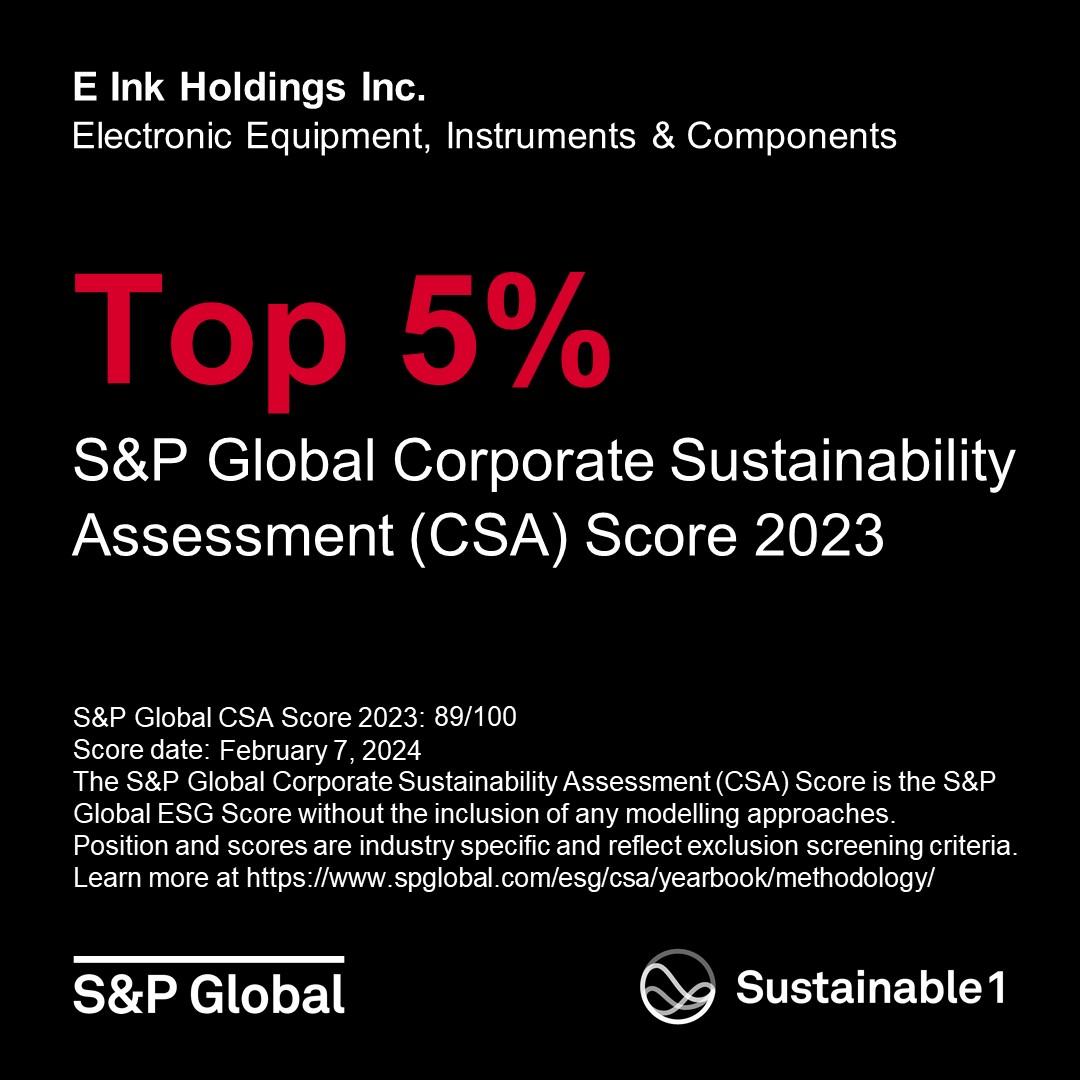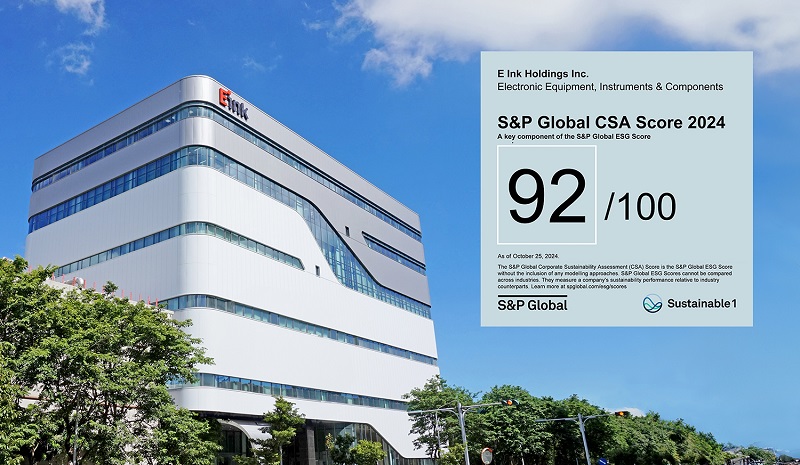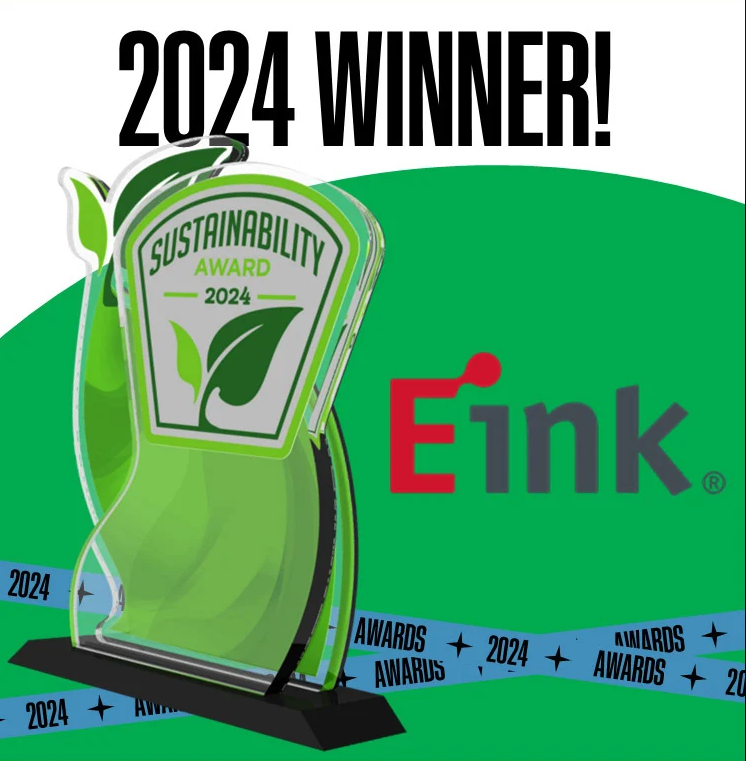
Recognized as an Early Adopter by the Taskforce on Nature-Related Financial Disclosures.
BILLERICA, Mass.-- E Ink (8069.TWO), the originator, pioneer, and global commercial leader in ePaper technology, proudly announces its continued recognition in the S&P Global Sustainability Yearbook 2024. This marks the company's second consecutive year of inclusion, reaffirming its commitment to sustainable practices. Additionally, E Ink has been honored as an Early Adopter by the Taskforce on Nature-related Financial Disclosures (TNFD), further solidifying its dedication to environmental stewardship.
In the latest Sustainability Yearbook by S&P Global, E Ink secured its place among the top 5% of enterprises within the Electronic Equipment, Instruments & Components industry (ITC), boasting an impressive score of 89 points.
Johnson Lee, CEO of E Ink, stated, "We are honored to be recognized in the S&P Global Sustainability Yearbook 2024. This acknowledgment reflects our ongoing commitment to excellence in ESG performance."
E Ink's outstanding performance is also highlighted in the 2023 S&P Global Corporate Sustainability Assessment (CSA), where the company attained a remarkable score of 89, positioning itself as the global leader in the Electronic Equipment, Instruments & Components industry. Across 25 evaluation criteria, E Ink excelled in various areas such as "Business Ethics," "Emissions," and "Human Capital Development," reaffirming its prominence in the industry.
The Sustainability Yearbook evaluates over 9,400 large corporations across 62 global industries, selecting only 759 leading companies based on their sustainability performance. E Ink's inclusion underscores its commitment to sustainability across all facets of its operations.
Furthermore, E Ink's proactive approach to environmental responsibility extends to its involvement in the TNFD initiative, launched in 2021 to promote transparency in corporate reporting of environmental risks and strategies. By joining TNFD as an Early Adopter, E Ink demonstrates its commitment to disclosing natural-related risks and strategies, aligning with global efforts to address climate change and biodiversity loss.
In addition to its TNFD Early Adopter status, E Ink actively supports ecosystem restoration and environmental sustainability through various initiatives. These include participation in the Science-based Targets Network (SBTN) Corporate Engagement Program and Business for Nature advocacy group, as well as the establishment of the Biodiversity and No-Deforestation Commitment. Through these efforts, E Ink remains at the forefront of sustainable business practices, actively contributing to the preservation of nature and biodiversity.
E Ink is committed to reaching RE100 by 2030 and Net Zero by 2040. The Company introduced the use of renewable energy in its global sites, and has optimized power consumption through highly efficient energy management systems. E Ink announced that by December 2022, the global operation and sales sites have achieved RE20, where 20 percent of the energy used by the company is generated from renewable sources. E Ink's factories and offices in Billerica, Fremont, and South Hadley in the United States, as well as sales offices in Tokyo, Japan, and Seoul, South Korea, have achieved the RE100 goal of using 100 percent renewable energy.
E Ink is also actively improving carbon reduction from product design and manufacturing processes, and conducts product carbon footprint verification. The Company provides customers with a carbon footprint framework for their ePaper products, and conducts low-carbon ePaper product design and development. According to the evaluation of the FTSE Russell Green Revenue 2.0 Data Model under the Energy Management Efficiency IT Process sub-sector, E Ink was identified as having 99.98 percent of Green Revenue in 2021 and has a positive impact on the environment, highlighting the environmental benefits of ePaper products. In September of 2023, E Ink announced that the company's science-based greenhouse gas (GHG) emissions reduction targets have been validated and approved by the Science Based Targets initiative (SBTi), for the near-term, long-term, and net-zero targets.
In addition, E Ink has been studying the CO2 effects of displays using paper or LCD versus electronic paper (ePaper) displays. Findings have shown significant CO2 savings with the use of E Ink ePaper displays.
- As an example, a financial institution with 125 branches saves 16.5 million A4-sized paper sheets each year when they adopt an eNote using E Ink's technology, and contributes approximately 1,100 tons of CO2 reduction each year.
- In the past 5 years, 130 million eReaders have been in use globally, replacing the purchase of paper editions of books. It is estimated that paper books would emit more than 100,000 times the CO2 versus eReaders with an E Ink display and LCD devices would emit more than 50 times the CO2 versus eReaders throughout that time.
- Over the past seven years, 600 million electronic shelf labels (ESLs) of around three inches in size have been installed worldwide. If it is assumed that the price and information is changed four (4) times a day, ePaper tags can reduce CO2 emissions by 32,000 times versus single-use paper price tags.
- Comparing the energy usage of ePaper retail tags versus LCD retail tags over a period of five years, with four updates per day, for every kilowatt hour (KWh) consumed to manufacture the ePaper material a savings of 400 KWh is realized.
- E Ink's low power ePaper enables solar-powered ePaper signage and bus stops around the world to be net-zero devices, using 100 percent renewable energy.

